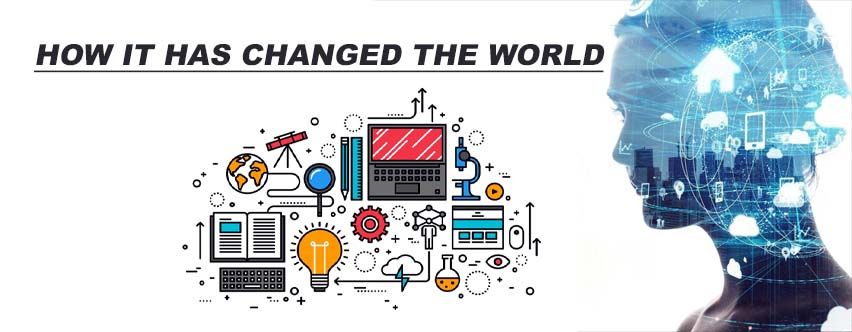In the modern era, Information Technology (IT) has become an indispensable part of our daily lives. From the way we communicate to how we work, shop, and even access healthcare, IT has revolutionized every aspect of our world. In this blog, we’ll explore how IT has transformed the world and delve into key statistics, a comparison table, and frequently asked questions to shed light on its profound impact.
Table of Contents
The Digital Revolution
The term “digital revolution” encapsulates the radical transformation brought about by IT. It signifies a shift from analog and mechanical technologies to digital ones. Let’s dive into how this transformation has changed the world.
Comparison Table:
| Aspect | Pre-IT Era | Post-IT Era |
|---|---|---|
| Communication | Snail mail, landlines | Email, smartphones, video conferencing |
| Business | Brick-and-mortar, manual processes | E-commerce, automation, data analytics |
| Healthcare | Paper records, limited diagnostics | Electronic Health Records (EHR), telemedicine |
| Education | Classroom-based, textbooks | Online learning platforms, e-books |
| Entertainment | Television, physical media | Streaming services, online gaming |
| Research | Libraries, paper journals | Online databases, collaborative research |
| Transportation | Paper tickets, physical maps | GPS navigation, ride-sharing apps |
| Social Interaction | Face-to-face, local | Social media, global connections |
Communication Transformation
Before IT, communication was relatively slow and localized. Snail mail and landline phones were the norm. Today, email, smartphones, and video conferencing have transformed the way we interact. We can communicate instantly with anyone globally, breaking down geographical barriers and fostering collaboration on a global scale.
Statistics:
- In 2021, there were approximately 4.9 billion internet users worldwide, up from 2.5 billion in 2012.
- In the same year, the number of active social media users exceeded 4.2 billion, marking a 13% increase from the previous year.
Business Evolution
Business operations have undergone a radical shift with IT. In the pre-IT era, brick-and-mortar establishments and manual processes prevailed. Today, e-commerce, automation, and data analytics have revolutionized industries. Businesses can reach wider audiences and operate efficiently with the help of IT tools and platforms.
Statistics:
- E-commerce sales worldwide amounted to $4.28 trillion in 2020, a significant increase from $1.84 trillion in 2016.
- In 2021, over 70% of organizations reported having adopted automation in some form.
Healthcare Transformation
The healthcare sector has seen a significant shift from paper records and limited diagnostics to Electronic Health Records (EHR) and telemedicine. IT has enabled remote patient monitoring, improving healthcare access and patient outcomes.
Statistics:
- The global telemedicine market is projected to reach $194.2 billion by 2023, growing at a CAGR of 16.9% from 2021.
- In the United States, the adoption of EHR systems among non-federal acute care hospitals reached 96% in 2019.
Education in the Digital Age
Traditional classroom-based education has evolved with the advent of IT. Online learning platforms, e-books, and digital resources have made education more accessible and flexible.
Statistics:
- The global e-learning market is expected to reach $336.98 billion by 2026.
- As of 2020, there were 2.6 million Coursera users and over 155 million edX users worldwide.
Entertainment Redefined
Entertainment has shifted from traditional television and physical media to streaming services and online gaming. IT has empowered consumers to access content on-demand, transforming the entertainment industry.
Statistics:
- In 2020, the global video streaming market was valued at $50.11 billion.
- The online gaming industry was valued at $159.3 billion in 2020.
Research and Collaboration
In the past, research relied on libraries and paper journals. IT has revolutionized research with online databases, collaborative tools, and easy access to vast amounts of information.
Statistics:
- Over 73% of researchers reported using Google Scholar as their primary research tool in 2020.
- In 2021, there were over 100,000 scholarly journals available online.
Transportation Revolution
The transportation sector has been reshaped by IT. Gone are the days of paper tickets and physical maps. GPS navigation and ride-sharing apps have made traveling more convenient and efficient.
Statistics:
- The global ride-sharing market size was estimated at $75.39 billion in 2020.
- Over 1.4 billion smartphones were sold worldwide in 2020, many equipped with GPS navigation.
Social Interaction Across Borders
Social interaction has transcended physical boundaries with the rise of social media. IT has enabled global connections, making the world a more interconnected place.
Statistics:
- Facebook, the largest social media platform, had 2.85 billion monthly active users as of 2021.
- In 2020, Twitter had 330 million monthly active users.
Frequently Asked Questions (FAQ)
Q1: How has IT improved healthcare? A1: IT has improved healthcare through Electronic Health Records (EHR), telemedicine, and remote patient monitoring, enhancing access to quality care.
Q2: What impact has IT had on education? A2: IT has made education more accessible and flexible with online learning platforms, e-books, and digital resources.
Q3: How has IT affected businesses? A3: IT has transformed business operations with e-commerce, automation, and data analytics, enabling efficiency and global reach.
Q4: What are some notable statistics about social media? A4: In 2021, there were over 4.2 billion active social media users globally, marking a significant increase from previous years.
Q5: How has IT changed transportation? A5: IT has revolutionized transportation with GPS navigation and ride-sharing apps, making travel more convenient and efficient.
Conclusion
Information Technology has undeniably changed the world in profound ways, reshaping how we communicate, conduct business, access healthcare, educate, entertain ourselves, conduct research, and interact socially. The digital revolution has brought numerous benefits, but it has also raised important questions about privacy, cybersecurity, and digital literacy. As we continue to embrace IT, it’s crucial to address these challenges while harnessing the transformative power of technology to create a brighter future.


Leave a Reply